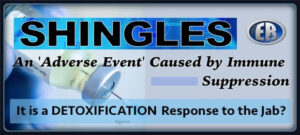Vaccines Are Sabotaging the Immune System – Shingles May Hold Some Answers
Fri 10:22 am +00:00, 10 Dec 2021
Vaccines Are Sabotaging the Immune System. Shingles May Hold Some Answers.
History suggests the condition known as shingles could well represent a detoxification reaction to vaccination.
Miss a day, miss a lot. Subscribe to The Defender’s Top News of the Day. It’s free.
Those package inserts, as damning as they still are, have just been eclipsed by shocking in-house Pfizer data, forced into view by a Freedom of Information Act (FOIA) request.
The company’s confidential inventorying of reactions, which was “never supposed to see the light of day,” shows that in the first 90 days of the injection’s emergency use (through Feb. 28, 2021), Pfizer recorded more than 158,000 different adverse events — including 1,223 deaths — distributed across 42,086 case reports,
While blood clots and heart problems following COVID vaccination have probably attracted the most widespread attention, Pfizer’s adverse event chart displaying 27 different “system organ classes” reveals wide-ranging problems — many of which highlight a disturbing “reprogramming” of recipients’ immune responses.
Post-vaccination shingles
Among the immune dysfunctions Pfizer noted to be “of special interest” (listed in the “other” category) were 281 events related to herpes zoster (popularly known as shingles), with a median onset of one day following COVID vaccination.
Shingles is a painful condition characterized by rash, blisters, burning or shooting nerve pain and a variety of potential complications. Up to 20% of shingles episodes affect the eyes, with the possibility of permanent vision impairment, including blindness.
The cases summarized by Pfizer through February are echoed in a growing number of patient, clinician and published reports that describe shingles, including ocular complications, as “untoward events” following COVID vaccination — many of them “first-in-a-lifetime” events.
Most occurred within days or weeks of injection, and some after just one dose of vaccine.
In a discussion of shingles and other skin reactions to the shots, roughly one in five reactions were categorized as serious or “very acute.”
Various European updates estimate shingles represents anywhere from 1.3% to 4.1% of total adverse events reported for COVID vaccines.
A study of the Pfizer vaccine published in the New England Journal of Medicine in September that used two different measures of risk and a data set of more than 2.4 million vaccinated Israelis confirmed the shot is associated with an excess risk of shingles — as well as myocarditis, lymph node abnormalities and appendicitis (the appendix is a “safe house” for important immune system cells).
Collectively, these reports pin blame not just on the Pfizer shots but also on Moderna’s mRNA shot and all the other major COVID vaccines in use around the world, including China’s Sinovac, India’s Covaxin and the injections developed by Janssen/Johnson & Johnson and AstraZeneca.
‘Not directly’ and ‘not necessarily’ linked?
Upholding the status quo position that adverse events such as shingles are merely “random occurrences,” the media are employing the usual cagey language to tell the public reported shingles outbreaks are “not directly” or “not necessarily” linked to COVID shots.
One doctor said, “I’ve seen a lot of shingles recently, but I haven’t seen it associated with the vaccine personally.”
Another doc said, “If people haven’t received the shingles vaccine and got shingles after getting the COVID vaccine, ‘it’s coincidence,’” flippantly adding, “nothing is risk-free.”
Yet another doctor circuitously stated, “It’s not that the vaccine caused the shingles — the vaccine was just one of what could have been many different triggers to have produced an episode of shingles.”
News outlets like Pharmacy Times agree “causality cannot yet be proved” but virtuously state “vigilance and safety monitoring … is warranted.”
The American Academy of Allergy, Asthma & Immunology (AAAAI) — collaborating with Harvard and other universities on a vaccine surveillance tool called the Vaccines and Medications in Pregnancy Surveillance System — should be interested in delving into potential safety signals.
However, AAAAI dismissed patient concerns about shingles and COVID shots. In an April “Ask the Expert” post, AAAAI asserted “there is no clear association between the [Pfizer] vaccine and shingles.”
Moreover, AAAI endorsed first-trimester COVID vaccination despite studies documenting alarming rates of pregnancy loss in women vaccinated in that time period.
All of these disingenuous “nothing to-see-here” statements contradict the medical community’s long-standing admission that immune suppression increases the risk of shingles, and its occasional grudging concession that the immune impact of vaccines represents a possible trigger.
Frustrated, consumers erupting with shingles are asking, “Is anyone tracking how many people are getting shingles after receiving the [COVID] vaccine?”
Some of the authors of recent case reports on COVID vaccines and shingles have cautiously staked out a response. Key facts such as shingles’ occurrence not just in immunocompromised COVID vaccine recipients but also in healthy individuals, and the “short delay of onset after vaccination,” have forced some to conclude the vaccines induce “immune dysregulation,” “alteration of immunity” or “immunomodulation” which provoke shingles.
Clues from influenza vaccination
Before COVID, online sites were swamped with accounts of people developing shingles within days or weeks of influenza vaccination.
In one instance, a man wrote of having consulted half a dozen medical professionals who all insisted “the flu shot cannot possibly cause shingles.”
After noting he developed his “first and only” outbreak of shingles “just 3 hrs after getting a flu shot,” he reported:
“I stopped getting flu shots. I have never had shingles since then. That’s some coincidence … [T]here’s enough money wrapped up in convincing older adults to get flu shots, that it’s in the industry’s interest to discount the possibility, to which I reply – BS.”
Many others posting to the same forum agreed they’re “not buying the ‘coincidence’ explanation,” including very healthy (i.e., immunocompetent) people in their 20s and 30s reporting “horrible” and “agonizing” cases of shingles shortly after getting flu shots.
On another forum, a moderator responded to the voluminous complaints about flu vaccines and shingles as follows:
“What we do know from our readers is this: There has been a correlation for all of them, and all of [them] have been told that there is no correlation. It’s very difficult for mere mortals to suggest there are serious side effects to vaccination when we are [led] to believe otherwise by doctors and Big Pharma.”
Clues from chickenpox and shingles vaccination
In 1995, FDA approved and the Centers for Disease Control and Prevention (CDC) added a chickenpox vaccine, Varivax, to the childhood schedule for 12- to 15-month-olds, playing up the risks of a largely trivial childhood illness that, at the time, was a nearly universal experience.
Following introduction of Varivax, cases of shingles skyrocketed in both adults and some children. Sometimes, kids who received the vaccine went on to develop chickenpox anyway, often a more severe case at older ages.
The Merck package inserts for both Varivax and its measles-mumps-rubella-varicella vaccine, ProQuad, plainly list shingles as an adverse event, as do several hepatitis vaccines and the meningococcal vaccine Menactra.
A decade after the introduction of chickenpox vaccination, far from admitting to any problems, CDC cited waning vaccine-induced immunity as justification for adding a chickenpox booster to the childhood schedule.
The agency also began recommending Merck’s Zostavax vaccine to “offset” increased shingles incidence in adults.
Merck pulled Zostavax from the market in late 2020 and is embroiled in lawsuits for vaccine injuries running “the gamut from contracting shingles as a result of the vaccine to serious personal injuries such as blindness in one eye, individuals who have serious paralysis in their extremities, brain damage, all the way to death.”
When a CDC whistleblower attempted to publish data documenting the increased incidence of shingles and other unwanted fallout from chickenpox vaccination, CDC personnel sought to bury the findings, including engaging in actions “contributing to obfuscation and malfeasance.”
Clues from history
In the early 20th century, scientists elaborated the hypothesis, still unproven, that shingles is linked to chickenpox and that they share a common viral origin.
New Zealand’s Dr. Sam Bailey explained, in an August 2021 video, however, that the “virus” in question (varicella zoster virus) is an artifact of cell culture experiments rather than proper virus isolation techniques.
Bailey also pointed out that, as with SARS-CoV-2, diagnosis of a chickenpox or shingles “viral infection” hinges on untrustworthy PCR testing never intended for such a purpose.
A top British whistleblower published a scathing critique of virology’s “voodoo scientism” which is compatible with Bailey’s remarks, asserting the methodology virologists use to claim “isolation … provides no confirmable connection with the material or physical world” and “the perversion of the word ‘isolation’ is delusional, dishonest and highly misleading.”
If a virus is not responsible for shingles, what is? History suggests the condition known as shingles could well represent a detoxification reaction to vaccination.
In the annals of medicine, 18th-century English scientist William Heberden was credited with the discovery of shingles (or chickenpox). In an era when physicians were enamored of developing “elaborate classifications” into which they could shoehorn various skin conditions, Heberden singled out an affliction characterized by pocks, arguing it was distinct from smallpox.
Coincidentally or not, this occurred a half-century after the 1721 London debut of the practice of smallpox “variolation” — which set the stage for “vaccination.”
At the time, smallpox was a central preoccupation. The variolation procedure involved the subcutaneous introduction into a healthy person of “fresh matter taken from a ripe pustule of some person who suffered from smallpox.”
Earlier this year, putting a positive spin on variolation as “the foundation for vaccine development,” Spanish dermatologists approvingly wrote in the International Journal of Dermatology, “There are some lessons from prevaccination times which can be considered for modern-day challenges.”
However, neither 18th-century vaccine crusader Edward Jenner nor later authors have ever said much about negative lessons, including the illnesses and deaths that ensued in many variolation/vaccination recipients.
Bearing in mind Bailey’s reminder that “outbreaks of disease don’t require an infectious agent because often the individuals involved are exposed to the same environmental conditions,” it seems reasonable to ask whether the novel skin condition identified by Heberden — and the reactions observed after our era’s COVID, influenza, chickenpox and other shots — are actually the body’s response to vaccination.
What else is ‘shingles’ hiding?
The group Doctors for COVID Ethics notes that lymphocytes (one type of white blood cell) are the “lifelong sentinels of the immune system” and help keep infections and tumors under control.
The authors of a recent case report on COVID-vaccine-induced shingles observed the injections cause “transient lymphocytopenia” (an abnormally low lymphocyte count) — with a “dose-dependent decrease in lymphocytes in the first days following injection” — and this might be a mechanism triggering shingles.
The fact that each individual reporting COVID vaccine injuries tends to describe multiple adverse events suggests shingles could represent the tip of a much larger iceberg.
For example, the authors of the large Israeli study documenting an increased incidence of shingles after COVID vaccination noted shingles is “one of the potential causes of facial-nerve palsy,” an adverse event independently highlighted as a safety signal.
In August, reporter Sharyl Attkisson reported that facial paralysis (including Bell’s palsy, facial weakness and “twitching”) was one of the most common adverse events reported thus far for COVID injections, and had become the focus of “investigations, warnings or stated concerns by public health officials.”
Dr. Ryan Cole, a pathologist, has observed an “uptick” in conditions like shingles and mononucleosis (“mono”) in the COVID-vaccinated. Patients, too, describe cases of mono kickstarted by the shots — and complications of mono include Bell’s palsy and other palsies.
Cole said, “We’re literally weakening the immune system of these individuals.”
While experts may continue to debate mechanisms of injury and which novel toxins and technologies may be most responsible, Pfizer’s in-house data and other global databases make it impossible to deny one key fact: A staggering volume and variety of injuries are occurring.
As journalist Celia Farber concluded after reviewing Pfizer’s “cold-blooded” disclosures, “Anybody who tells you these ‘vaccines’ are safe is somewhere between hypnotized, dishonest and malicious.”
************
Source
Published to The Liberty Beacon from EuropeReloaded.com
Vaccines Are Sabotaging the Immune System – Shingles May Hold Some Answers














